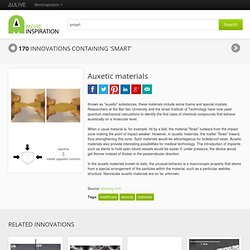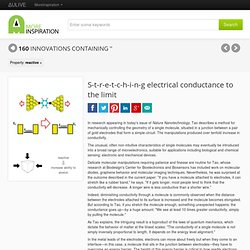

Silicon Velcro. An exotic form of silicon that can be stuck together and then peeled apart has been developed by German researchers.
Thematerial, dubbed "silicon Velcro", could be used to manufacturemicroprocessors and devices that manipulate fluids on microscopicscales. Researchers at the Technical Universityof Ilmenau in Germany created the material from "black silicon". Thisis generated when normal silicon is hit with a powerful laser beam orbombarded with high-energy ions, producing a dense, microscopic arrayof needle-like structures on its surface.
Light bounces around betweenthe needles without escaping to give the material its black appearance. Auxetic materials. Known as "auxetic" substances, these materials include some foams and special crystals.

Researchers at the Bar-Ilan University and the Israel Institute of Technology have now used quantum mechanical calculations to identify the first class of chemical compounds that behave auxetically on a molecular level. When a usual material is, for example, hit by a ball, the material "flows" outward from the impact zone making the point of impact weaker. However, in auxetic materials, the matter "flows" inward, thus strengthening this zone. Such materials would be advantageous for bulletproof vests. Auxetic materials also provide interesting possibilities for medical technology. In the auxetic materials known to date, the unusual behavior is a macroscopic property that stems from a special arrangement of the particles within the material, such as a particular weblike structure. Source: physorg.com. d3o shock absorbing technology. Artificial gecko coating. If engineers could create a material that matches the nimble lizard's incredible grip, we could make super-grip shoes for athletes and tyres that hold the road better in all weathers, for example.

The hairs on a gecko's feet - called setae - are the key to its remarkable grip on just about any surface, rough or smooth, wet or dry. The tips of the setae are so sticky that geckos can hang from a ceiling with their entire weight suspended from a single toe.Two microscopic polymer bumps, roughly the same size as those on a seta, have the same sticking power as a gecko hair.
Although, individually, these forces do not amount to much, millions of them combine to produce the gecko's impressive sticking power.Now an engineer called Metin Sitti at Carnegie Mellon University in Pittsburgh, has created some polymer-based setae. They are not yet strong enough to hold an adult human on a ceiling, but they are slowly getting there.
Source: newscientist.com. Conductive polymer can be both flexible and rigid. The boffins at Sony's Tokyo labs are working on a clever way to get bulky electronic devices into small pockets.

Their plan is to create handheld computers, phones and portable games consoles that fold up for carrying and then become rigid for use.The body and screen of folding gadgets would be made from a flexible polymer containing conductive rubber bracing struts filled with a gel of aluminosilicate particles suspended in silicone oil.When a current is passed through the struts, the particles clump together and harden the gel, making the gadget solid enough to use.
Sony has found that it would take very little power to make such a folding device harden, so the drain on its battery should be low. The company's patent adds that the transition from soft to hard takes just milliseconds. It suggests that the same technique could even be used in a video game controller to make it jolt or change shape in response to on-screen action. Source: newscientist.com. Method, system and computer product for performing geometric dimension and tolerance stack-up analysis. Portable computer display tilt/swivel mechanism and method. PriorIP. Multiaxial hinge assembly with rotational direction indicator. S-t-r-e-t-c-h-i-n-g electrical conductance to the limit. In research appearing in today's issue of Nature Nanotechnology, Tao describes a method for mechanically controlling the geometry of a single molecule, situated in a junction between a pair of gold electrodes that form a simple circuit.

The manipulations produced over tenfold increase in conductivity. The unusual, often non-intuitive characteristics of single molecules may eventually be introduced into a broad range of microelectronics, suitable for applications including biological and chemical sensing; electronic and mechanical devices. Delicate molecular manipulations requiring patience and finesse are routine for Tao, whose research at Biodesign's Center for Bioelectronics and Biosensors has included work on molecular diodes, graphene behavior and molecular imaging techniques. Nevertheless, he was surprised at the outcome described in the current paper: "If you have a molecule attached to electrodes, it can stretch like a rubber band," he says. Source: physorg.com.